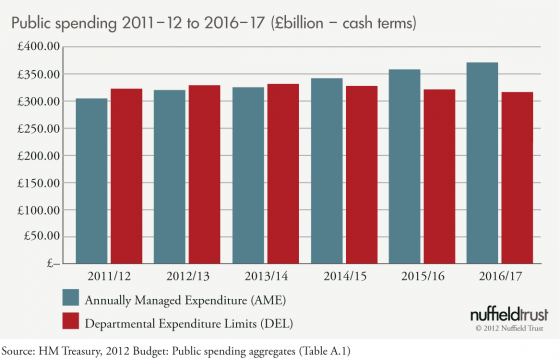The Chancellor made no announcements on the future of the NHS in his 2012 Budget statement. Yet, the contents of the Budget report have quite profound implications for NHS funding.
They also reveal some interesting facts about the short-term.
Short-term movements
According to the 2010 Spending Review, the Government planned to spend £105.9 billion in 2011-12 on health in England. In Budget 2012, that total is now £900 million less.
While £400 million has been added to health spending plans for 2012-13, it still leaves health with £500 million less than the Government announced in the Spending Review.
Although a number of NHS Trusts are in deficit, the NHS as a whole is forecasting a significant surplus for 2011-12 (£1.2 billion at the end of quarter two). The NHS surplus is clearly contributing to the Department of Health’s overall under-spend but it now looks like some of that under-spend – £500 million of it – will not be coming back to health.
This must raise questions about the effectiveness of the NHS productivity programme (QIPP). The argument for front-loading efficiency plans was to generate money to reinvest in transforming services so that they would be sustainable in later years as the impact of constrained funding started to bite.
Instead, it seems that at least some of the savings are not going to be reinvested in new models of service delivery but will instead be channelled towards central Government deficit reduction.
Medium-term outlook
To get to grips with what the Budget means for the medium term you need to understand some public finance jargon and a bit of recent history.
First the history: the Chancellor wants to get the UK’s public finances back into balance. He set himself a fiscal mandate which crudely amounts to spending no more than the Government receives from tax, after allowing for cyclical fluctuations in the economy.
His initial aim was to achieve this by 2015 but economic growth over the last 18 months has been much lower than forecast, so last autumn he decided to give himself a bit more time and said he would meet the rule by 2017.
To meet this rule, Government spending will have to fall in real terms by 0.9 per cent a year between 2015 and 2017.
The Budget provides more insight into what that might mean for health and the bottom line is that things look very tough – probably tougher than the current £20 billion efficiency target.
To understand why, there’s a bit of jargon. Total Government spending is called TME (totally managed expenditure). It’s split into capital spending and resource spending (resource in health terms includes salaries, running costs and pharmaceuticals).
Both of these are further split into something called annually managed expenditure (AME) and departmental expenditure limits (DEL).
AME includes social security payments and debt interest and DEL consists of the fixed budgets for public services (health, education, transport etc.) which are set in the Spending Review.
The chart below shows the path of AME and DEL resource budgets if there is no policy change. This is in cash terms not adjusted for inflation.

From the Budget we know what the Government, and its forecasters at the Office for Budget Responsibility (OBR), expect to happen to DEL and AME in the two years after the current Spending Review.
Debt interest increases coupled with rising public sector pension costs and social security payments, all mean that resource AME will grow by 1.8 per cent a year in real terms. That leaves the total pot for public services falling by 3.8 per cent a year in real terms in 2015-16 and 2016-17.
That is a much larger cut than signalled in the current Spending Review, when spending on public services was cut by 2.3 per cent a year in real terms. The Chancellor said he would look to further welfare cuts to keep the reduction at the same level as the current Spending Review.
If he does cut the welfare budget where does this leave health? With a further two years of spending being broadly flat in real terms?
Possibly, but only if the rest of the public sector takes a further very big cut. Or will health have to share the pain with a 2.3 per cent real terms reduction?
Four years of holding NHS spending flat and two years of real terms cuts would definitely be unprecedented. Asking the NHS to take an equal share of the pain across the public services amounts to a productivity challenge of around six per cent.
And if the full 3.8 per cent real terms cut were to be applied to health’s resource budget, it would mean about £3 billion less in cash terms for the NHS in 2016-17 than in 2014-15.
Productivity gains on this scale don’t seem very realistic, especially given the outlook for pay, which is such a large part of NHS spending.
A big part of the current NHS productivity savings are being delivered by the pay freeze for health workers earning about £21,500 followed by the one per cent cap on pay awards.
This is hard medicine, with inflation substantially above target but wage growth across the economy as a whole being low, unemployment is high and the NHS is not encountering significant recruitment and retention problems.
By 2015-16, the economy is expected to be growing and the OBR forecasts that average earnings across the economy will be increasing by 4.5 per cent. Holding down public sector pay against this background looks very tough.
So what the Budget didn’t announce, but implies, is that if welfare spending can be cut by a further £10 billion and other public services are cut in cash terms, the NHS might get a further two years of broadly flat spending in real terms.
But, if either of those things are judged to be too difficult politically or too damaging to vulnerable groups and key services outside health, health spending will have to fall in real terms.
Whatever happens, the NHS needs to plan for two more years of belt tightening and it needs to be prepared for them to be tougher than they are now.
Suggested citation
Charlesworth A (2012) ‘What the Budget means for the NHS: a bit less now, a lot less later?’. Nuffield Trust comment, 24 March 2012. https://www.nuffieldtrust.org.uk/news-item/what-the-budget-means-for-the-nhs-a-bit-less-now-a-lot-less-later
